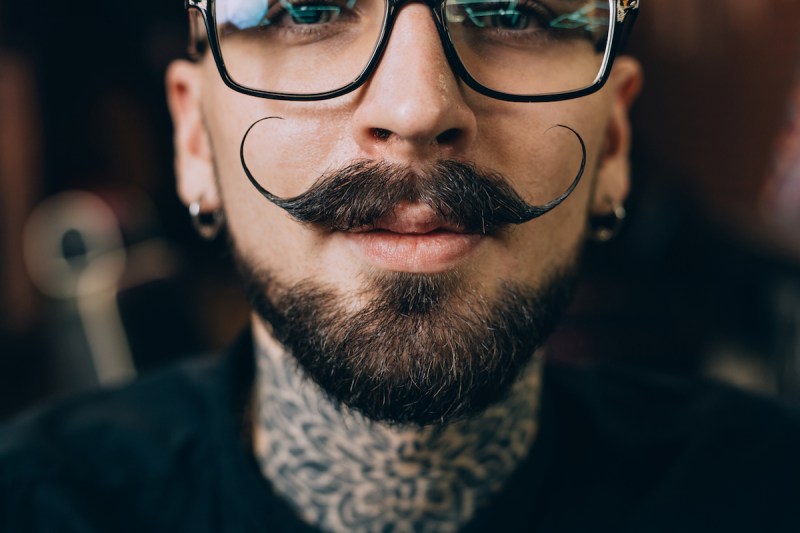
Facial hair can be the ultimate statement, the perfect way to make a first impression, whether bearded, sporting some scruff, or naturally mastering how to grow a mustache. Be it the fact that the pandemic changed everyone’s daily routines — and grooming routines — or the desire to try something new, some guys went all-in on growing a mustache and never looked back.
Perhaps seeing so many mustache-clad gentlemen out there has inspired you to grow your own mustache, but as with anything in the grooming department, there’s a right way and a wrong way to go about doing so. Mastering the art of growing a mustache is a lot like growing out and caring for your beard, as you’ll see, but with some nuances along the way. For instance, you need the right tools — like the best mustache wax (more on that in a minute). Here’s our guide on how to grow a mustache — and really pull it off.

How to grow a mustache
It all starts with a single step, a significant move on the path to growing a mustache. As simple as it may sound, the first step in growing a mustache, in our humble opinion:
- Start by growing a beard for two to three weeks– yes, really! This will provide time for your mustache to grow in alongside your beard– a gradual transition that makes a big difference.
- From there, trim down your beard to an agreeable length using a good beard trimmer — preferably, down to stubble as you’d normally shave. Take this process slowly.
- While there’s nothing you can do to make your mustache grow thicker or more fully (although some supplements could potentially help that process), from there, it’s all about removing the rest of your facial hair and leaving only your mustache standing tall.
There are different types of mustache styles you’ll want to consider, which is another crucial part of our tips on how to grow a mustache.

Which mustache style works for me?
There are certainly plenty of mustache styles out there. A mustache with accompanying scruff, a sort of mustache-beard hybrid, is a popular style these days. The handlebar mustache, with delicately styled designs held in place by mustache wax, is yet another option favored by the especially “hip” crowd.
The most common style of mustache might be the classic option: a full mustache alongside a clean-shaven face and no goatee. This means the mustache doesn’t taper off, like a handlebar mustache, and it’s not connected to a goatee on the lower half of your face.
Here are a few tips on maintaining this classic style of mustache:
- Ensure your mustache is a well-groomed one and not overly long, overly bushy, or thick (mustache and beard trimmers can help with this goal).
- Use mustache wax to hold loose or unruly hairs in place.
- Groom and brush your mustache regularly, as you would with your beard.
- Trim as often as you need, but if you want to stand out quietly, rather than being overly loud, avoid the handlebar mustache style.

How long does it take to grow a mustache?
The answer to the tricky question: “How long does it take to grow a mustache?” is a complicated one at times, as everyone’s facial hair grows at a different rate. The shortest answer might be that it typically takes about as long as it takes for you to grow a full beard, or at least a beard that’s beyond stubble. So, it could take two to three weeks or shorter — or longer.
The best tip we can give you is to be patient — growing a mustache goes hand in hand with growing a beard.
Again, everyone’s facial hair grows at a different rate, but whatever works for you is the best process that’s going to help set you on the path to growing the best mustache possible.

Why is my mustache not growing?
We can’t all be so lucky. Some of us have inherited good facial hair genes, while others of us were never endowed with such a thing. Give growing one a shot, but if you don’t see facial hair really filling in above the lip after about a week or so, the style may not be for you.
There are ways to patch in some additional facial hair and you can even try certain nutrients like protein, iron, boron, and zinc to inspire growth, but don’t go out of your way if it’s not coming in naturally. Sometimes, growing a good ‘stache is more trouble than it’s worth.

A few last thoughts
The art of growing a mustache moves at a different pace for everyone, but if you start with a solid base, like a beard, for instance, you’re well on your way to getting the precise mustache you want. Keep it nicely groomed and use mustache wax to style it. Also, make use of a beard or mustache trimmer to keep unruly hairs in check.
Treat it with care, just as you would a full beard, and the compliments will start to roll in as you achieve facial hair perfection. Growing a mustache — and really pulling it off — is well within your reach if you follow the tips we’ve outlined here. Who knows: It could even become your style signature.
We’ve got plenty more grooming pieces on the subject. Check out our guide on the best beard styles for older men and the most popular short hairstyles. Look good, feel good, do good.

